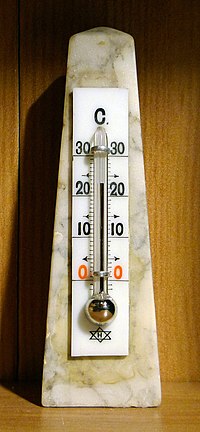
Photo from wikipedia
ABSTRACT The aim of the study was to investigate the feasibility of evaluating heat loss from the body surface of horses during exercise on a treadmill using dynamic infrared thermography… Click to show full abstract
ABSTRACT The aim of the study was to investigate the feasibility of evaluating heat loss from the body surface of horses during exercise on a treadmill using dynamic infrared thermography (IRT). Continuous measurements of body surface temperature change at walk, trot, and during recovery time were collected from five horses using a thermographic camera. Horses were exercised on the treadmill for 25 minutes: 10 minutes of walk, 10 minutes of trot, 5 minutes of walk, and ending with 10 minutes of recovery time. Four thermograms per minute were extracted from the original 30 Hz video sequences for temperature analysis. Four regions of interest (ROIs) were positioned on each analyzed thermographic image including neck (NC), shoulder (SH), chest (CH), and croup area. At baseline, the NC was the hottest ROI, followed by the SH. By the end of the first walk, the temperature at all ROIs had increased, with the NC area remaining the warmest. During the trot, temperature increased for the first 5 minutes, with the greatest increase in temperature in the CH area. During the second walk, the temperatures started to decline in all regions. By the end of the recovery period, temperature had reduced at all regions, with the NC and CH areas demonstrating the biggest drop in temperature. It was found that heat loss from the body surface during exercise can be evaluated by means of dynamic body surface temperature measurement with IRT. More research is now required to fully explore the physiological changes of the equine musculoskeletal system during exercise. HighlightsHeat loss is evaluated by means of dynamic body surface temperature measurement.Dynamic temperature measurement provided information on heat dissipation.Thermography is a technique which reveals the evolution of temperature in real time.
Journal Title: Journal of Equine Veterinary Science
Year Published: 2018
Link to full text (if available)
Share on Social Media: Sign Up to like & get
recommendations!